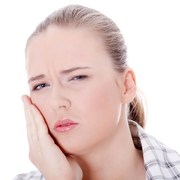 B-D-S/PhotoSpin
B-D-S/PhotoSpin
"Temporomandibular joint" is quite a mouthful, so the acronym TMJ is often used instead. The TMJ is the hinge joint connecting the mandible to the skull's temporal bone.
The temporal bone is located in front of each ear. The ligaments, muscles and joints on each side of your jaw are attached to the jaw joint.
They let you open your mouth and close it again. They're the reason you can chew, swallow and talk.
This system works wonderfully, when it works, but it can be thrown off by a number of problems.
Some disorders of the TMJ are osteoarthritis and rheumatoid arthritis, bruxism (grinding teeth), dislocation, misalignment of jaw or teeth, or injury. Stress can cause muscles of the jaw or face to tighten or teeth to clench.
Your face, jaw joint, neck, shoulders, around the ear, or in the ear may be tender or sore when you chew or speak, or when opening your mouth wide.
You may not be able to open your mouth as widely as you could before. Your jaw may get stuck either open or closed.
You may have clicking, grating or popping sounds which may or may not be painful when moving your jaws.
Chewing may be painful or may feel "off". You may have swelling on one side of the face or the other, or both sides.
Pain from temporomandibular disorders can be temporary for some people or it may last for years. Women are more likely to get TMD than men are. It is most likely to hit between age 20 and 40.
Your dentist can perform an examination in the case of TMD and depending on the findings, may send you to a doctor or another dentist.
The National Institute of Dental and Craniofacial Research offers this information for those suffering from TMD.
It can be helpful to eat softer foods. Don't bite your nails or chew gum. Pain may be eased by using heat packs. Some people find relief through meditation, biofeedback or other types of relaxation techniques to reduce jaw tension.
The NIDCR also suggested strengthening your jaw muscles through exercise. If you grind or clench your teeth, use of a bite plate or a night guard may lessen this.
Your dentist can prescribe medication such as anti-anxiety drugs, anti-inflammatory drugs, muscle relaxants and pain relievers.
Avoid seemingly benign gestures or positions like resting your chin on your hand or snugging the phone between ear and shoulder. These movements can set you up for increased TMD symptoms.
If you have an uneven bite your dentist may suggest that you have your teeth adjusted or fixed, or seek orthodontic work.
Temporary situations that may seem similar to TMD include arthritis, gum disease, sinus issues or toothache. Your dentist will be able to determine what you're dealing with.
Sources:
TMJ. Mouthhealthy.org. Retrieved Nov. 13, 2012.
http://www.mouthhealthy.org/en/az-topics/t/tmj.aspx
Temporomandibular Disorders (TMD). WebMD.com. Retrieved Nov. 13, 2012.
http://www.webmd.com/oral-health/guide/temporomandibular-disorders
Visit Jody's website and blog at http://www.ncubator.ca and http://ncubator.ca/blogger
Reviewed November 14, 2012
by Michele Blacksberg RN




Add a Comment1 Comments
TMJ Disorder affects so many people and it can be quite debilitating. Thanks for share.
November 15, 2012 - 11:12amThis Comment